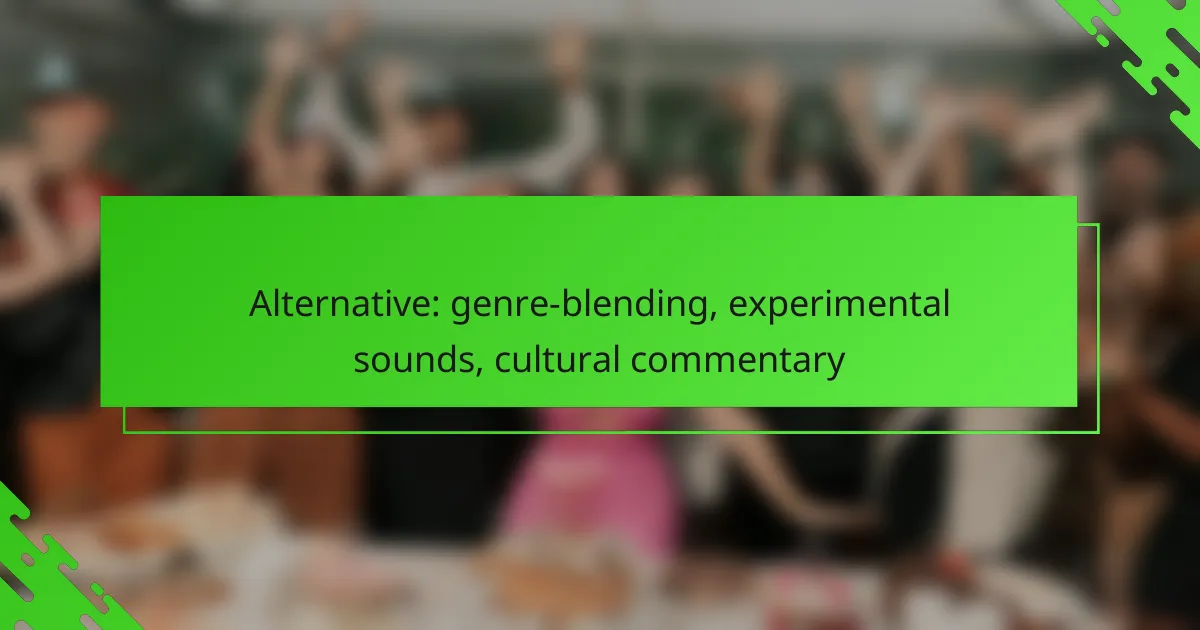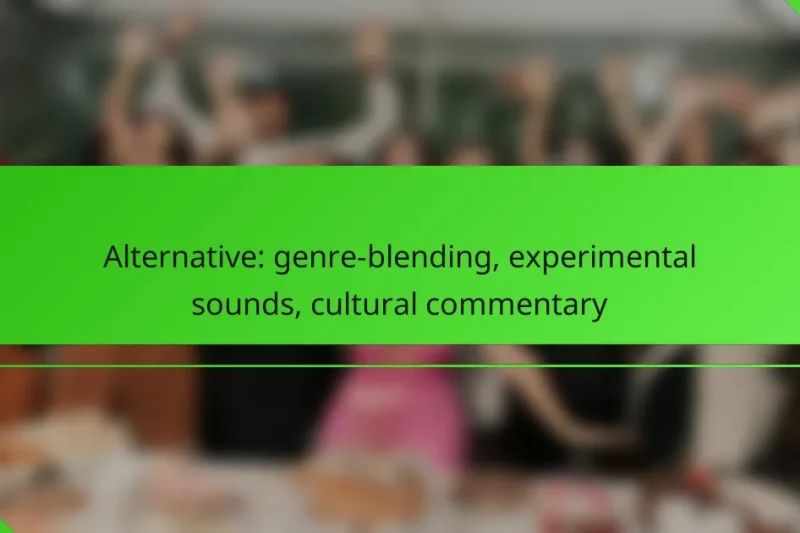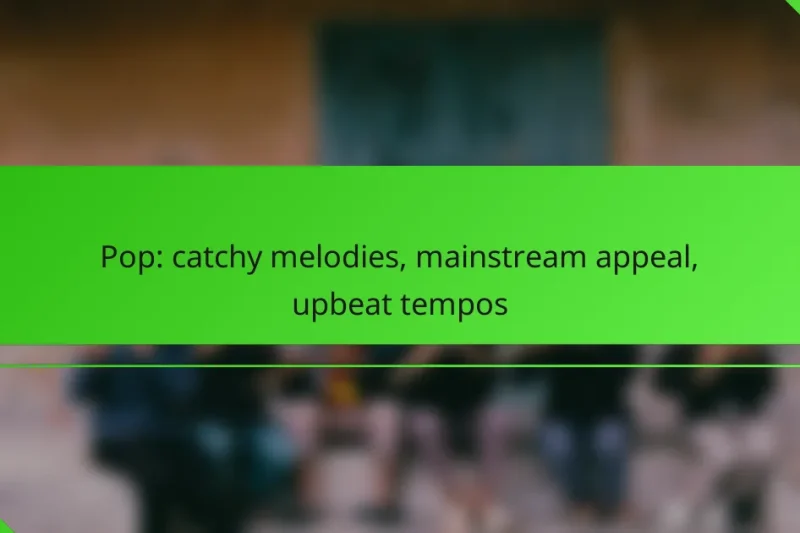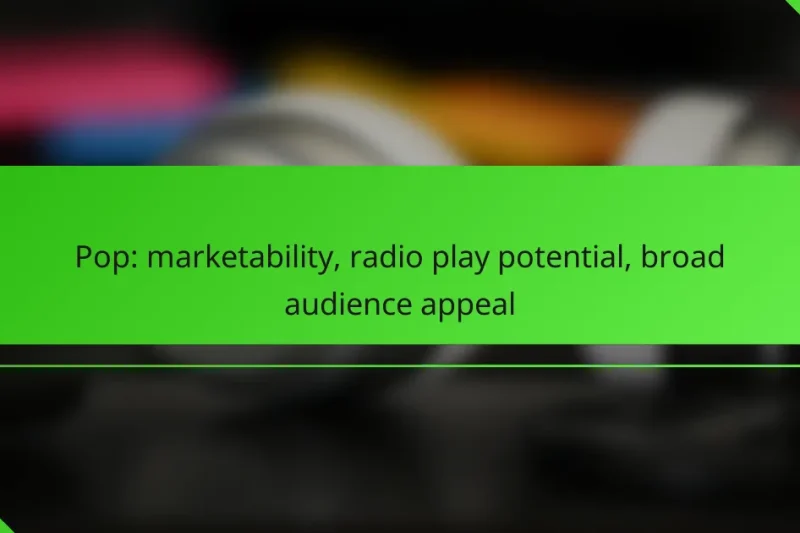In the realm of contemporary music, genre-blending albums are at the forefront, merging diverse styles and … Alternative: genre-blending, experimental sounds, cultural commentaryRead more
Music genres serve as a reflection of cultural diversity and personal identity, influencing both listener preferences and purchasing behaviors. From pop to hip-hop, each genre possesses unique characteristics that define its sound and appeal, shaping the way audiences connect with music. Understanding these genres and their variants allows us to appreciate the rich tapestry of musical expression found around the world.
Indie: artistic freedom, niche markets, experimental elements
Indie artists thrive on artistic freedom, enabling them to explore unique visions and connect authentically with … Indie: artistic freedom, niche markets, experimental elementsRead more
Metal: aggressive sound, powerful vocals, subgenre diversity
Metal music is characterized by its aggressive sound and powerful vocals, creating an intense auditory experience … Metal: aggressive sound, powerful vocals, subgenre diversityRead more
R&B: influence on pop music, emotional storytelling, cultural significance
R&B has a profound influence on pop music, particularly in Canada, where its rhythms and emotional … R&B: influence on pop music, emotional storytelling, cultural significanceRead more
Pop: catchy melodies, mainstream appeal, upbeat tempos
Pop music captivates listeners with its catchy melodies, upbeat tempos, and widespread mainstream appeal. These characteristics … Pop: catchy melodies, mainstream appeal, upbeat temposRead more
Rock: energetic, diverse influences, strong rhythms
Rock music is a vibrant genre characterized by its strong rhythms and energetic performances, making it … Rock: energetic, diverse influences, strong rhythmsRead more
Pop: marketability, radio play potential, broad audience appeal
Pop music’s marketability hinges on a variety of factors that signal a song’s potential for commercial … Pop: marketability, radio play potential, broad audience appealRead more
Country: storytelling lyrics, acoustic instruments, regional roots
In Canada, storytelling lyrics are integral to acoustic music, imbuing it with emotional depth and cultural … Country: storytelling lyrics, acoustic instruments, regional rootsRead more
Folk: preservation of culture, storytelling importance, community bonding
Folk culture is essential for preserving community identity, as it upholds traditions, stories, and practices that … Folk: preservation of culture, storytelling importance, community bondingRead more
Electronic: synthesized sounds, club culture, innovative production
Electronic music is characterized by its innovative use of synthesized sounds, which are crafted through various … Electronic: synthesized sounds, club culture, innovative productionRead more
What are the most popular music genres in Canada?
The most popular music genres in Canada include pop, rock, hip-hop, country, and electronic music. These genres reflect the diverse cultural landscape of the country and are widely enjoyed across various demographics.
Pop music
Pop music in Canada is characterized by catchy melodies and widespread appeal. Artists like Justin Bieber and Drake have significantly influenced the genre, often blending elements from various styles to create hits that resonate with a broad audience.
When exploring pop music, consider its commercial success and radio play, which often dictate trends. Streaming platforms also play a crucial role in promoting new pop artists and songs, making it easier for listeners to discover fresh talent.
Rock music
Rock music has a rich history in Canada, with legendary bands like Rush and The Tragically Hip shaping its identity. The genre encompasses various sub-genres, including alternative, punk, and classic rock, appealing to a wide range of listeners.
To appreciate rock music, pay attention to live performances, which are a significant aspect of the genre. Many Canadian rock festivals showcase both established and emerging artists, offering fans a chance to experience the music firsthand.
Hip-hop
Hip-hop has gained immense popularity in Canada, with artists like Drake and The Weeknd leading the charge. This genre often addresses social issues and personal experiences, resonating with many listeners.
Canadian hip-hop is notable for its diversity, incorporating influences from various cultures. Engaging with local hip-hop scenes and attending live shows can provide deeper insights into the genre's evolution and its impact on Canadian culture.
Country music
Country music in Canada blends traditional sounds with modern influences, appealing to both rural and urban audiences. Artists like Shania Twain and Brett Kissel have brought Canadian country music to international prominence.
When exploring country music, consider the storytelling aspect, which often reflects personal and communal experiences. Country music festivals across Canada provide opportunities to enjoy live performances and discover new artists.
Electronic music
Electronic music has surged in popularity in Canada, with festivals like Electric Daisy Carnival showcasing top DJs and producers. The genre encompasses various styles, including house, techno, and dubstep, attracting a diverse audience.
To fully appreciate electronic music, explore local scenes and underground events, which often feature emerging talent. Understanding the production techniques and technology behind electronic music can enhance your listening experience and appreciation for the genre.
How do music genres influence purchasing decisions?
Music genres significantly impact purchasing decisions by shaping consumer preferences and behavior. When individuals identify with a specific genre, they are more likely to buy related products, such as albums, merchandise, and concert tickets.
Genre-based playlists
Genre-based playlists curate songs that resonate with specific musical styles, making them appealing to fans of those genres. These playlists often drive engagement on streaming platforms, leading to increased sales of featured tracks and albums.
For example, a playlist focused on indie rock may attract listeners who are more inclined to purchase concert tickets or merchandise from indie artists. Brands can leverage this by creating targeted marketing campaigns that align with popular playlists.
Artist collaborations
Collaborations between artists from different genres can broaden their audience and influence purchasing behavior. When an artist known for pop music collaborates with a hip-hop artist, it can attract fans from both genres, increasing sales across both demographics.
Such collaborations often lead to unique merchandise and special edition albums, which can drive higher sales. Fans are likely to purchase these exclusive items as a way to support their favorite artists and celebrate the collaboration.
Concert ticket sales
Concert ticket sales are heavily influenced by music genres, as fans are more likely to attend live performances of artists within their preferred genre. Genre popularity can dictate ticket pricing, with more popular genres often commanding higher prices.
For instance, a rock concert may see ticket prices ranging from $50 to $150, depending on the artist's fame and the venue. Promoters should consider genre trends when planning events to maximize attendance and revenue.
What are the key characteristics of each music genre?
Each music genre is defined by distinct characteristics that shape its sound and appeal. Key elements include rhythm and tempo, instrumentation, and lyrical themes, which collectively create the unique identity of a genre.
Rhythm and tempo
Rhythm and tempo are foundational aspects of any music genre, influencing how listeners perceive and engage with the music. For example, genres like hip-hop often feature a strong, steady beat, while jazz may incorporate complex rhythms and varying tempos.
In general, genres can be categorized by their tempo ranges: fast-paced genres like techno typically range from 120 to 150 beats per minute, while slower genres like ballads may fall between 60 to 80 beats per minute. Understanding these differences helps in selecting appropriate music for various settings.
Instrumentation
Instrumentation varies widely across music genres, impacting the overall sound and texture. For instance, rock music often features electric guitars, bass, and drums, while classical music relies on orchestral instruments such as violins, cellos, and woodwinds.
When exploring genres, consider the typical instruments used. For example, country music frequently incorporates acoustic guitars and banjos, while electronic music may rely heavily on synthesizers and drum machines. This knowledge can guide listeners in discovering new music within their preferred styles.
Lyrical themes
Lyrical themes are crucial in defining a music genre's emotional and cultural resonance. Genres like pop often focus on love and relationships, while punk music may address social issues and rebellion. Understanding these themes can deepen appreciation for the music.
When analyzing lyrics, pay attention to common motifs. For instance, folk music frequently tells stories of personal experiences or historical events, while rap may explore themes of identity and struggle. Recognizing these patterns can enhance the listening experience and foster a connection to the genre.
How do music genres vary regionally in Canada?
In Canada, music genres reflect the country's diverse cultural landscape, with distinct styles emerging from various regions. This regional variation is influenced by historical, social, and cultural factors, leading to unique musical expressions across the nation.
Indigenous music
Indigenous music in Canada encompasses a wide range of styles, often rooted in the traditions of First Nations, Inuit, and Métis peoples. This genre features unique instruments like the drum and flute, and often includes vocal styles that convey storytelling and cultural heritage.
Contemporary Indigenous musicians blend traditional elements with modern genres, creating a fusion that resonates with both Indigenous and non-Indigenous audiences. Notable artists like Buffy Sainte-Marie and A Tribe Called Red highlight this evolution, showcasing the richness of Indigenous music today.
Franco-Ontarian music
Franco-Ontarian music represents the French-speaking population in Ontario, featuring genres that range from folk to contemporary pop. This music often incorporates themes of identity and culture, reflecting the experiences of Francophones in a predominantly English-speaking province.
Artists such as La Chicane and Marie-Jo Thério have made significant contributions to this genre, blending traditional French influences with modern sounds. Festivals like the Franco-Ontarian Festival in Ottawa celebrate this vibrant musical scene, promoting local talent and cultural pride.
West Coast music styles
The West Coast of Canada is known for its diverse music scene, heavily influenced by the region's multicultural population and natural landscapes. Genres such as folk, rock, and electronic music thrive here, with artists often drawing inspiration from the Pacific environment.
Notable West Coast musicians include the folk-rock group The Tragically Hip and electronic artist Deadmau5. The region hosts various music festivals, such as the Vancouver Folk Music Festival, which showcase both local and international talent, fostering a rich musical community.
What are the emerging music genres in Canada?
Emerging music genres in Canada reflect a diverse cultural landscape, blending traditional influences with modern sounds. Notable genres include indie pop, lo-fi hip-hop, and experimental electronic, each showcasing unique characteristics and growing popularity.
Indie pop
Indie pop is characterized by its melodic tunes and often introspective lyrics, typically produced outside of major record labels. This genre emphasizes artistic expression and has gained traction in urban centers like Toronto and Vancouver, where local artists frequently collaborate and share their work online.
Listeners appreciate indie pop for its authenticity and relatability. Popular Canadian indie pop artists include Alvvays and Jessie Ware, who have successfully captured audiences with their catchy hooks and heartfelt themes.
Lo-fi hip-hop
Lo-fi hip-hop blends hip-hop beats with mellow, often jazzy instrumentals, creating a relaxed listening experience. This genre has surged in popularity, particularly among students and young professionals who use it as background music for studying or working.
In Canada, lo-fi hip-hop artists often share their music on platforms like Bandcamp and SoundCloud, allowing for easy access and discovery. The genre's appeal lies in its soothing soundscapes and the DIY ethos that resonates with many creators.
Experimental electronic
Experimental electronic music pushes the boundaries of sound, incorporating unconventional techniques and technology. This genre often features a mix of synthesized sounds, field recordings, and innovative production methods, appealing to listeners who seek new auditory experiences.
Canadian artists like Amon Tobin and Tim Hecker are known for their contributions to experimental electronic music, often performing at festivals such as MUTEK. This genre encourages exploration and creativity, making it a vibrant part of Canada's music scene.














